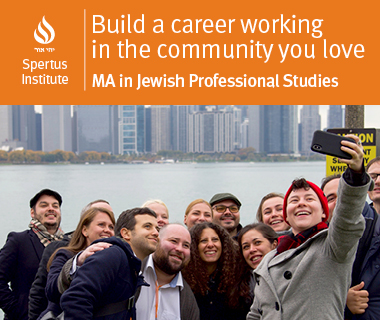Holy moments in the holy land
Permanent link All PostsIt was the summer solstice.
My friend and I had just left the Western Wall when we happened upon hundreds of people lining the streets of Jerusalem at sunset holding hands, dancing, and singing "Salaam (Od Yavo Shalom Aleinu)," an Israeli song, sung in Hebrew and Arabic, that's come to symbolize a call for peace.
Some donned dreads, others kippot, and a couple people wore keffiyehs. A few beat on drums, forming drum circles with kids in the crowd.
Maybe if I had witnessed a similar scene in Chicago, my street-smart instincts would have whispered to turn away from the unusual display of people dancing in front of me.
But I was feeling the love, they were singing my favorite Jewish song, and I figured, "When in Jerusalem…"
So I jumped right in and interlaced hands with an Asian woman on one side and a 30-something man in a kippah on the other.
"What is all this?" I asked the man.
"It's called the 'Jerusalem Hug,'" he replied.
In honor of the first day of summer, he explained to me, the Hug beckons hundreds of Jerusalemites and visitors to the city to stand shoulder to shoulder in a demonstration of love, peace, and unity.
.jpg)
One of the organizers of the 'Jerusalem Hug,' leading the crowd through the city.
In a way, the scene couldn't have been more simple—people holding hands with each other. But then again, especially just steps from the Wall, the moment felt holy.
This summer marked my fourth trip to Israel. I had traveled there to participate in the World Zionist Organization-sponsored conference on "Women and Zionism" for 20 young Jewish women from around the world, as well as the Israeli Presidential Conference, under the auspices of Israeli President Shimon Peres.
On past visits, the planner in me structured my itinerary carefully, touring the country's majestic, holy Jewish tourist sites, like the Wall, Masada, and Safed. But in my free time on this trip, I let the wind carry me.
And it's no accident that it was on this visit that I felt most connected to the fabric of Israeli society sharing spontaneous encounters with Israeli people like my fellow hand-holders in Jerusalem. It was in these small, unplanned moments, I felt the power of this holiest place on earth.
Indeed, I felt a holy connection to the people and land of Israel when:
I tasted fresh watermelon at the open-air market.
I swam in the Mediterranean Sea, as warm as bath water.
I shared a seat on a city bus next to a local commuter.
I struck up a conversation with young Israeli guys at an outdoor bar on a breezy Jerusalem night under a crescent moon.
One of the speakers we heard from at the World Zionist Organization conference was a brilliant professor named Gil Troy. A Queens, N.Y. native, Troy taught history at McGill University in Montreal for many years before making aliyah with his wife and two young children. His favorite part about living in Israel, he told us, is doing "normal activities," like taking his daughter to ballet and watching his son practice soccer, in a Jewish state.
To him, and to me, there is holiness in the mundane in this unique place.
After the conference ended in Jerusalem, I took a bus to Tel Aviv. There, I spent a few days with Leah-- my Jewish American best friend from childhood—and her Israeli boyfriend, Itay. After initially meeting in Manhattan, they relocated to Itay's beloved hometown of Tel Aviv three years ago.
Leah and Itay gave me the kind of Israeli education you can't get from climbing Masada; they taught me about what it's like to really live in Israel.
Leah is starting her own fashion design business. When she's not working, she's exercising at Israeli boot camp by the sea, learning Hebrew, and taking on the daunting task of Israeli driver's ed—where she's killing two birds with one stone by learning to swear in Hebrew from a chain smoking, gravel-voiced Israeli woman. Itay is a computer consultant, specializing in technological educational resources for students.
The three of us shared a lot of deep conversations during my weekend in town on topics like what it means to be a Jewish minority in the diaspora versus part of the Jewish majority in Israel.
One warm Tel Aviv night, on our way home from eating sushi and drinking sake at a Tel Aviv sushi joint, Leah, Itay, and I bumped into a crowd of peaceful organizers—more than 1,000 strong—at one of the social protests commonplace in Tel Aviv last summer and this summer.
Israelis marched and chanted in support of civil rights for all members of Israeli society. To the delight of the crowd, a bus driver left his vehicle in the middle of the street, where traffic was at a standstill, and danced with the protesters.
And just like in Jerusalem, I joined in, this time with my friends, marching down the street with the Israeli people—another holy moment in the holy land.



.jpg)



